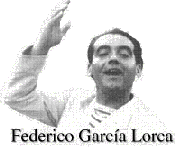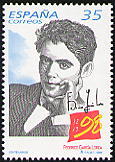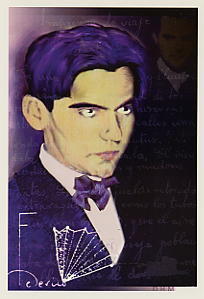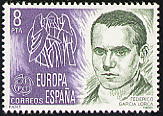| EPELSA
/ MOBBA ISSUES 1998 |
FEDERICO
GARCÍA LORCA. LA BARRACA /
FEDERICO GARCIA
LORCA. THE THATCHED HOUSE |
| Click
on the image to enlarge it |
 |
|
Date
of issue :
|
|
October 1998 |
|
Size
:
|
|
47 x 27 mm. |
|
Paper
:
|
|
Thermal self
adhesive - multicoloured |
|
Imprint
:
|
|
Thermal on
black |
|
Design
:
|
|
FNMT. |
|
Printer
:
|
|
FNMT. Fábrica
Nacional de Moneda y Timbre |
|
Printing
:
|
|
50.281.600
of labels |
|
 |
Federico García
Lorca was born on June 5, 1898 in Fuente Vaqueros (Granada).
When he was 11 he moved with his family to live in Granada, where he studied
piano, getting his General Certificate of Education and beginning to study
Law as well as Arts and Philosophy at university. In 1919 he moved to Madrid
to carry on with his studies and he lodged in the famous "Residencia
de Estudiantes" ( Students hall of residence ), where he made friends
with a group of intellects who stood out for their avant-garde attitudes
in the different fields of art ; Luís Buñuel, Salvador Dalí
and Pepín Bello, amongst others, were some of the most significant
personalities at that moment. His passion for Literature was made evident
very soon in the numerous works he published, which were very successful
amongst public. Lorca was a friend of Manuel de Falla, participating with
him in 1922 in the organization of the Festival de Cante Jondo (
Andalusian folk song festival ) in Granada, and Falla guided him in the
music and lyrics of his Poema de Cante Jondo. |
In 1929 Lorca travelled to
the United States going with the politician Fernando de los Rios, and there
he wrote his famous book Poeta en Nueva York ( A poet in
New York ). He went to Cuba sometime later, where he gave some talks and
poetry readings which made him succeed. He wrote El público
and
Así que pasen cinco años in Cuba. When
the 2nd Republic was proclaimed García Lorca identified himself
with its cultural project and he was entrust with the direction of "La
Barraca", ( The Thatched house ), a university travelling
theatre company whose mission was performing classical plays in villages
and towns. Amongst his vast lyric oeuvre we cannot forget his Romancero
gitano and Llanto por la muerte de Ignacio Sánchez
Mejía, which was inspired by the death of his great friend
and bullfighter. Amongst his plays we must mention Bodas de sangre,
Yerma,
La
casa de Bernarda Alba and Doña Rosita la soltera.
The civil war took him by surprise in Granada and he was assassinated one
early morning in August, 1936.
Information
: Informativo 15/98 Servicio Filatélico

|




